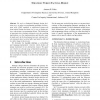Free Online Productivity Tools
i2Speak
i2Symbol
i2OCR
iTex2Img
iWeb2Print
iWeb2Shot
i2Type
iPdf2Split
iPdf2Merge
i2Bopomofo
i2Arabic
i2Style
i2Image
i2PDF
iLatex2Rtf
Sci2ools
HICSS
2005
IEEE
2005
IEEE
Strategic Versus Tactical Design
Abstract. We seek to distinguish Strategic design decisions (e.g., to adopt a programming paradigm, architectural style, CBSE standard or application framework) from tactical design decisions (e.g. to use a design pattern, refactoring or programming idiom). This distinction is important since strategic statements carry far-reaching implications over the implementation and therefore must be made early in the development process, whereas tactical statements have localized effect and must be deferred to a latter stage in the process. We formulate the Locality criterion, a well-defined and language-independent criterion which divides all tatements in two abstraction classes. We apply our criterion to a broad range of statements and demonstrate that strategic statements are non-local and that tactical design statements are local. We also demonstrate that assumptions leading to architectural mismatch are non-local. Strategic design decisions determine the primary behavioural and structural p...
Biometrics | Design Decisions | HICSS 2005 | Strategic Design Decisions | System Sciences | Tactical Design |
| Added | 24 Jun 2010 |
| Updated | 24 Jun 2010 |
| Type | Conference |
| Year | 2005 |
| Where | HICSS |
| Authors | Amnon H. Eden |
Comments (0)

